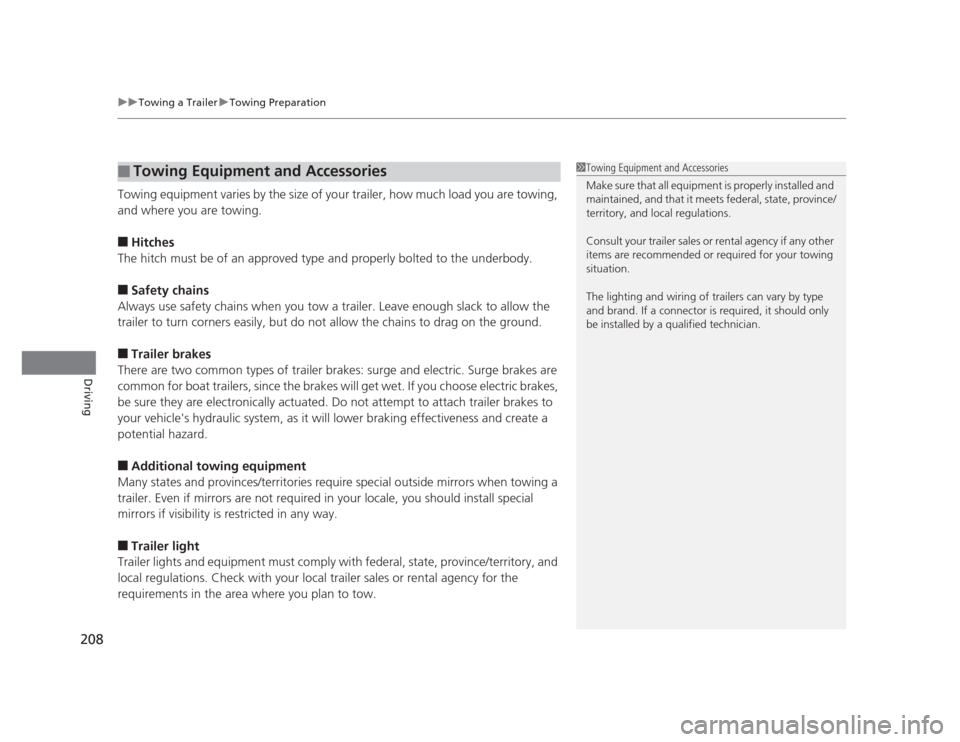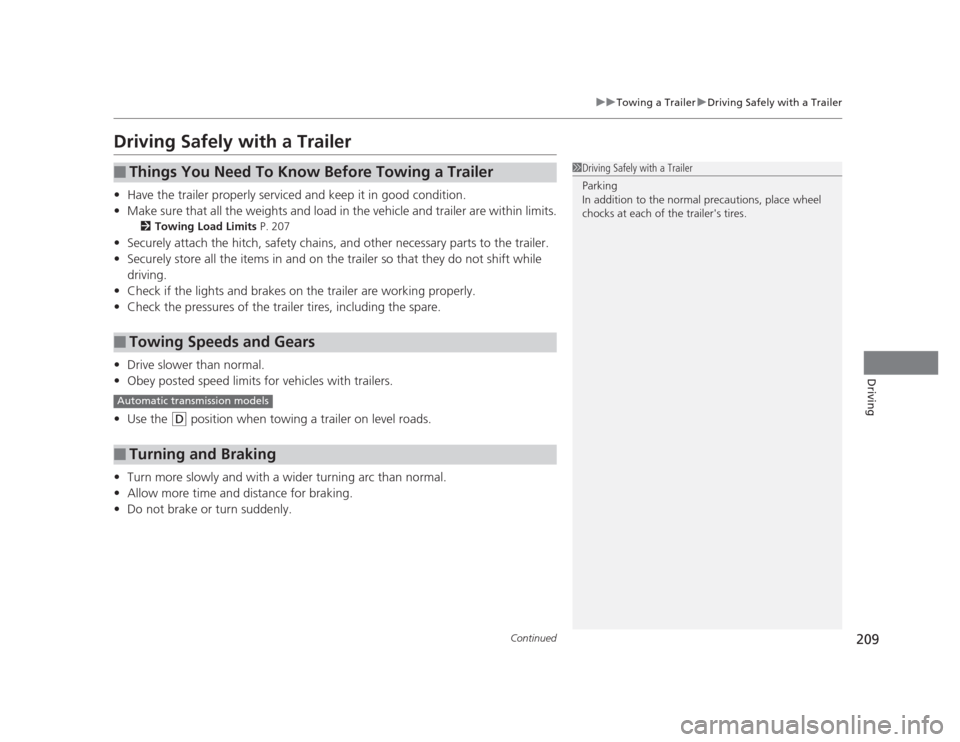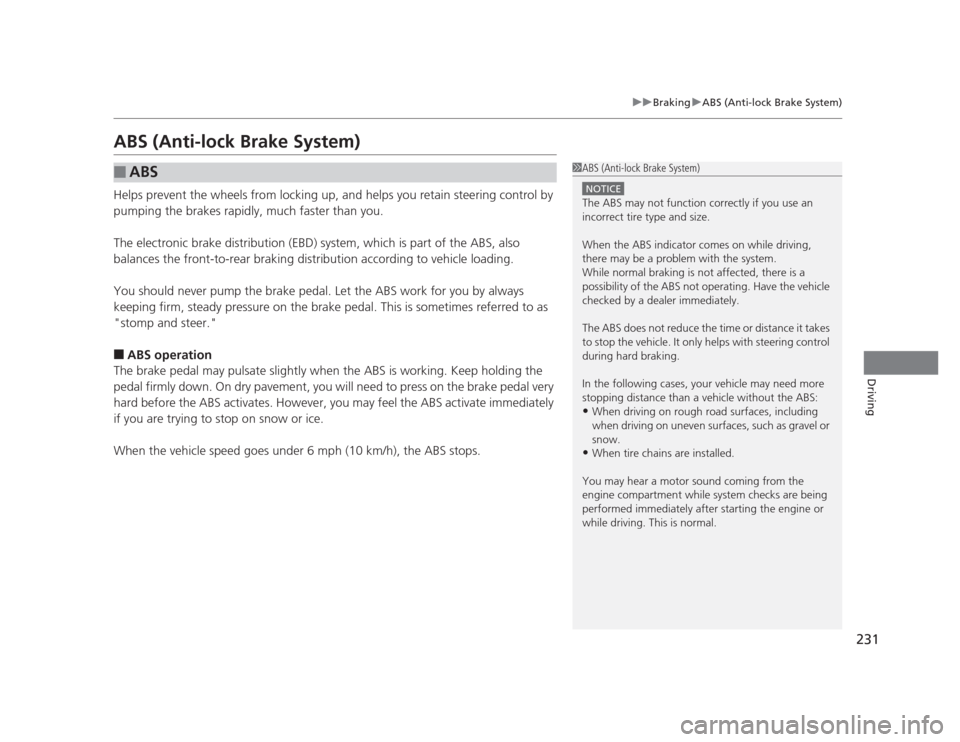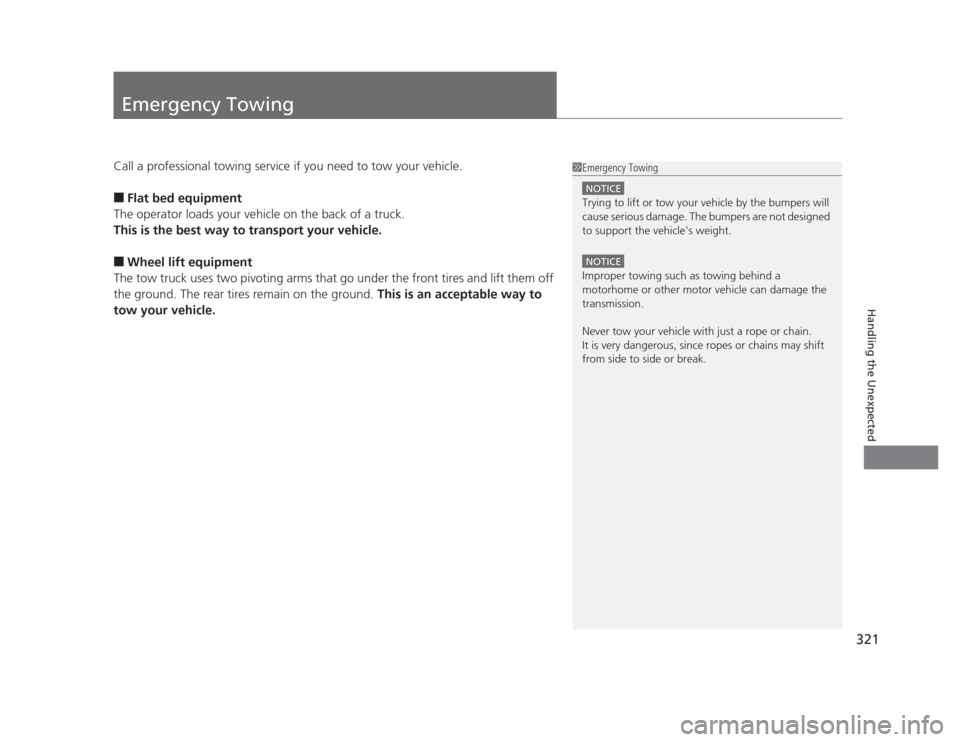2012 HONDA CIVIC chains
[x] Cancel search: chainsPage 209 of 345

uuTowing a TraileruTowing Preparation
208
Driving
Towing equipment varies by the size of your trailer, how much load you are towing,
and where you are towing. ■ Hitches
The hitch must be of an approved type and properly bolted to the underbody. ■ Safety chains
Always use safety chains when you tow a trailer. Leave enough slack to allow the
trailer to turn corners easily, but do not allow the chains to drag on the ground. ■ Trailer brakes
There are two common types of trailer brakes: surge and electric. Surge brakes are
common for boat trailers, since the brakes will get wet. If you choose electric brakes,
be sure they are electronically actuated. Do not attempt to attach trailer brakes to
your vehicle's hydraulic system, as it will lower braking effectiveness and create a
potential hazard. ■ Additional towing equipment
Many states and provinces/territories require special outside mirrors when towing a trailer. Even if mirrors are not required in your locale, you should install special
mirrors if visibility is restricted in any way.
■ Trailer light
Trailer lights and equipment must comply with federal, state, province/territory, and
local regulations. Check with your local trailer sales or rental agency for the
requirements in the area where you plan to tow.
■Towing Equipment and Accessories1Towing Equipment and Accessories
Make sure that all equipment is properly installed and
maintained, and that it meets federal, state, province/
territory, and local regulations.
Consult your trailer sales or rental agency if any other
items are recommended or required for your towing
situation.
The lighting and wiring of trailers can vary by type
and brand. If a connector is required, it should only
be installed by a qualified technician.
Page 210 of 345

209
uuTowing a TraileruDriving Safely with a Trailer
Continued
Driving
Driving Safely with a Trailer •Have the trailer properly serviced and keep it in good condition.
• Make sure that all the weights and load in the vehicle and trailer are within limits.
2 Towing Load Limits P. 207
• Securely attach the hitch, safety chains, and other necessary parts to the trailer.
• Securely store all the items in and on the trailer so that they do not shift while
driving.
• Check if the lights and brakes on the trailer are working properly.
• Check the pressures of the trailer tires, including the spare.
• Drive slower than normal.
• Obey posted speed limits for vehicles with trailers.
• Use the
(D position when towing a trailer on level roads.
• Turn more slowly and with a wider turning arc than normal.
• Allow more time and distance for braking.
• Do not brake or turn suddenly.
■Things You Need To Kn ow Before Towing a Trailer
■Towing Speeds and Gears
■Turning and Braking
1Driving Safely with a Trailer
Parking
In addition to the normal precautions, place wheel
chocks at each of the trailer's tires.
Automatic transmission models
Page 232 of 345

231
uuBrakinguABS (Anti-lock Brake System)
Driving
ABS (Anti-lock Brake System)
Helps prevent the wheels from locking up, and helps you retain steering control by
pumping the brakes rapidly, much faster than you.
The electronic brake distribution (EBD) system, which is part of the ABS, also
balances the front-to-rear braking distribution according to vehicle loading.
You should never pump the brake pedal. Let the ABS work for you by always
keeping firm, steady pressure on the brake pedal. This is sometimes referred to as
"stomp and steer." ■ABS operation
The brake pedal may pulsate slightly when the ABS is working. Keep holding the
pedal firmly down. On dry pavement, you will need to press on the brake pedal very
hard before the ABS activates. However, you may feel the ABS activate immediately
if you are trying to stop on snow or ice.
When the vehicle speed goes under 6 mph (10 km/h), the ABS stops.
■ABS1ABS (Anti-lock Brake System)
NOTICE
The ABS may not function correctly if you use an
incorrect tire type and size.
When the ABS indicator comes on while driving,
there may be a problem with the system.
While normal braking is not affected, there is a
possibility of the ABS not operating. Have the vehicle checked by a dealer immediately.
The ABS does not reduce the time or distance it takes
to stop the vehicle. It only helps with steering control
during hard braking.
In the following cases, your vehicle may need more
stopping distance than a vehicle without the ABS: • When driving on rough road surfaces, including
when driving on uneven surfaces, such as gravel or
snow.
• When tire chains are installed.
You may hear a motor sound coming from the
engine compartment while system checks are being
performed immediately after starting the engine or
while driving. This is normal.
Page 289 of 345

288
uuChecking and Maintaining TiresuWinter Tires
Maintenance
Winter Tires
If driving on snowy or frozen roads, mount all season marked ”M+S” tires, snow
tires, or tire chains; reduce speed; and maintain sufficient distance between vehicles when driving.
Be particularly careful when operating the steering wheel or brakes to prevent
skidding.
Use tire chains, snow tires, or all season tires when necessary or according to the law.
When mounting, refer to the following points.
For winter tires: • Select the size and load ranges that are the same as the original tires.
• Mount the tires to all four wheels.
For tire chains:• Install them on the front tires only.
• Because your vehicle has limited tire clearance, we strongly recommend using the
chains listed below:
• Follow the chain manufacturer's instruc tion when installing. Mount them as
tightly as you can.
• Check that the chains do not touch the brake lines or suspension.
• Drive slowly.
Cable-type: SCC Radial Chain SC1030
Cable-type: SCC Radial Chain SC1032
1Winter Tires
NOTICE
Traction devices that are the wrong size or improperly
installed can damage your vehicle's brake lines,
suspension, body, and wheels. Stop driving if they are
hitting any part of the vehicle.
When tire chains are mounted, follow the chain
manufacturer's instructions regarding vehicle
operational limits.
If your vehicle is equipped with summer tires, be
aware that these tires are not designed for winter
driving conditions. For more information, contact a dealer.
3WARNING
Using the wrong chains, or not properly
installing chains, can damage the brake
lines and cause a crash in which you can be
seriously injured or killed.
Follow all instruction s in this owner's
manual regarding the selection and use of
tire chains.
Models with P195/65R15 tires
Models with P205/55R16 tires
Models with P215/45R17 tires
Models with 215/45ZR17 tires
Page 300 of 345

299
Continued
Handling the Unexpected
If a Tire Goes Flat
Changing a Flat Tire
If a tire goes flat while driving, grasp the steering wheel firmly, and brake gradually
to reduce speed. Then, stop in a safe place. Replace the flat tire with a compact
spare tire. Go to a dealer as soon as possible to have the full size tire repaired or
replaced. 1.
Park the vehicle on firm, level, and non-slippery ground.
2. Put the shift lever in
(P .
2. Put the shift lever in
(R .
3. Set the parking brake.
4. Turn on the hazard warning lights and turn the ignition switch to LOCK
(0.
1Changing a Flat Tire
Periodically check the tire pressure of the compact
spare. It should be set to the specified pressure.
Specified Pressure: 60 psi (420 kPa, 4.2 kgf/cm 2
)
When driving with the compact spare tire, keep the
vehicle speed under 50 mph (80 km/h). Replace with
a full size tire as soon as possible.
The compact spare tire and wheel in your vehicle are
specifically for this model.
Do not use them with another vehicle.
Do not use another type of compact spare tire or
wheel with your vehicle.
Do not mount tire chains on a compact spare tire.
If a chain-mounted front tire goes flat, remove one of
the full-size rear tires and replace it with the compact
spare tire. Remove the flat front tire and replace it
with the full size tire that was removed from the rear.
Mount the tire chains on the front tire.
Do not use a puncture-repairing agent on a flat tire,
as it can damage the tire pressure sensor.
U.S. models only
Automatic transmission models
Manual transmission models
All models
Page 322 of 345

321
Handling the Unexpected
Emergency Towing
Call a professional towing service if you need to tow your vehicle. ■Flat bed equipment
The operator loads your vehicle on the back of a truck.
This is the best way to transport your vehicle. ■ Wheel lift equipment
The tow truck uses two pivoting arms that go under the front tires and lift them off
the ground. The rear tires remain on the ground. This is an acceptable way to
tow your vehicle.1Emergency Towing
NOTICE
Trying to lift or tow your vehicle by the bumpers will
cause serious damage. The bumpers are not designed
to support the vehicle's weight.
NOTICE
Improper towing such as towing behind a
motorhome or other motor vehicle can damage the
transmission.
Never tow your vehicle with just a rope or chain.
It is very dangerous, since ropes or chains may shift
from side to side or break.
Page 344 of 345

343
INDEX
SRS Airbags (Airbags)................................ 38
Starting the Engine .................................. 211
Does Not Start ........................................ 306
Engine Switch Buzzer .............................. 117
Jump Starting ......................................... 307
Steering Wheel ........................................ 124
Adjusting ................................................ 124
Stopping ................................................... 233
Summer Tires ............................................ 288
Supplemental Restraint System (SRS) ....... 38
Switches (Around the Steering Wheel) ............................. 2, 3, 117
System Message Indicator ......................... 72
T
Tachometer ................................................ 78
Temperature
High Temperature Indicator ....... ............... 69
Low Temperature Indicator ....................... 74
Outside Temperature Display .................... 85
Temperature Sensor .................................. 85
Time (Setting) ............................................. 98
Tire Pressure Monitoring System
(TPMS) ..................................................... 225
Indicator ............................. 71, 72, 316, 317
Tires .......................................................... 280
Air Pressure............................. 281, 325, 327 Checking and Maintaining ...................... 280
Inspection ............................................... 280
Labeling .................................................. 281 Puncture (Flat Tire)................................... 299
Regulations ............................................. 283
Rotation .................................................. 287
Spare Tire ................................ 299, 325, 327
Summer .................................................. 288
Tire Chains .............................................. 288
Wear Indicators ....................................... 285
Winter ..................................................... 288
Tools .......................................................... 298
Towing a Trailer ....................................... 207
Equipment and Accessories ..................... 208
Load Limits .............................................. 207
Towing Your Vehicle ................................ 210
Emergency .............................................. 321
TPMS (Tire Pressure Monitoring
System) .................................................... 225
Indicator .............................. 71, 72, 316, 317
Transmission ..................................... 215, 217
Automatic ............................................... 215
Fluid ................................................ 263, 264
Manual.................................................... 217
Number ................................................... 328
Shift Position Indicator ....................... 67, 216
Trip Meter ............................................. 80, 83
Troubleshooting ....................................... 297
Blown Fuse ...................................... 318, 319
Brake Pedal Vibrates .................................. 19
Buzzer Sounds When Opening Door .......... 20
Emergency Towing .................................. 321
Engine Won’t Start .................................. 306
Noise When Braking .................................. 20 Overheating ............................................ 311
Premium Gasoline ........................... 234, 326
Puncture/Flat Tire .................................... 299
Rear Door Won’t Open...................... 19, 104
Select Lever Won’t Move ......................... 310
Warning Indicators .................................... 66
Trunk ......................................................... 109
Lid........................................................... 109
Light Bulb........................................ 324, 326
Turn Signals .............................................. 118
Indicators (Instrument Panel) ..................... 73
U
Unlocking the Doors ................................ 101
Unlocking the Front Doors from the Inside ......................................... 11
USB Adapter Cable ........................... 144, 145
USB Flash Drives ....................................... 176
VValet Key ................................................... 100
Vanity Mirrors ............................................... 5
Vehicle Identification Number ................ 328
Vehicle Stability Assist (VSA ®
).................. 223
Off Button............................................... 224
Off Indicator.............................................. 70
System Indicator ........................................ 70
Viscosity (Oil) ............................ 254, 325, 327
VSA ®
(Vehicle Stability Assist) .................. 223
Page 345 of 345

344
INDEX
W
Wallpaper.................................................... 93
Warning and Information Messages ......... 76
Warning Indicator On/Blinking ................ 313
Warning Labels ........................................... 63
Warranties (Warranty Manual provided
separately) ............................................... 333
Watts ................................................. 324, 326
Wear Indicators (Tire) ............................... 285
Wheel Cover .............................................. 303
Wheel Nut Wrench (Jack Handle) ............ 302
Window Washers ...................................... 121
Adding/Refilling Fluid ............................... 267
Switch ..................................................... 121
Windows (Opening and Closing) ............. 114
Windshield ................................................ 121
Cleaning .................................................. 295
Defrosting/Defogging .............................. 142
Washer Fluid............................................ 267
Wiper Blades ........................................... 278
Wipers and Washers ................................ 121
Winter Tires ............................................... 288
Snow Tires ............................................... 288
Tire Chains .............................................. 288
Wipers and Washers ................................. 121
Checking and Replacing Wiper Blades ..... 278
WMA ......................................... 151, 161, 167
Worn Tires ................................................. 280